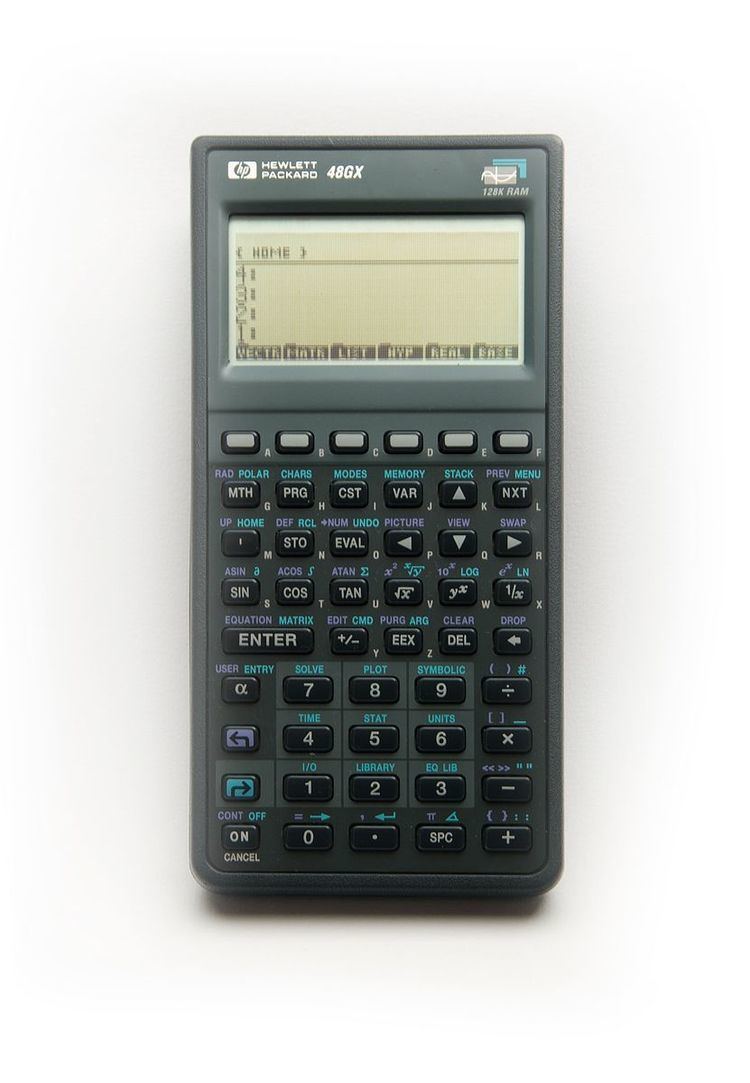Discontinued 2003 Successor HP 49G | Introduced 1990 Predecessor HP-28S | |
 | ||
Type ProgrammableScientificGraphing | ||
The HP 48 is a series of graphing calculators using Reverse Polish Notation (RPN) and the RPL programming language, produced by Hewlett-Packard from 1990 until 2003. The series include the HP 48S, HP 48SX, HP 48G, HP 48GX, and HP 48G+, the G models being expanded and improved versions of the S models. The models with an X suffix are expandable via special RAM (memory expansion) and ROM (software application) cards. In particular, the GX models have more onboard memory than the G models. The G+ models have more onboard memory only. The SX and S models have the same amount of onboard memory.
Contents
- Models Availability
- Specifications
- Common for all models
- HP48SHP48SX specific
- HP48GHP48GXHP48G specific
- Programming
- Emulators
- In popular culture
- References
Note that the similarly named hp 48gII (2004) is not really a member of the series, but rather much more closely related to the hp 49g+.
The hardware architecture developed for the HP 48 series became the basis for the HP 38G, with a simplified user interface and an infix input method, and the HP 49G with various software enhancements. Likewise, the hardware and software design of the HP 48 calculators are themselves strongly influenced by other calculators in the HP line, most of all by the HP-18C and the HP-28 series.
Models / Availability
The HP 48SX was introduced on 1990-03-06.
Availability:
Specifications
The HP 48 series' Saturn microprocessor is a hybrid 64-bit / 20-bit CPU hardware-wise but acts like a 4-bit processor in that it presents nibble-based data to programs and uses a nibble-based addressing system. The main registers A, B, C, D, along with temp registers R0, R1, R2, R3, and R4 are a full 64-bits wide, but the data registers D0 & D1 are only 20-bit. External logical data fetches are transparently converted to 8-bit physical fetches. The processor has a 20-bit address bus available to code but due to the presence of the high/low nibble selection bit, only 19 bits are available externally.
In both the HP 48S/SX and G/GX series, the Saturn CPU core is integrated as part of a more complex integrated circuit (IC) package. These packages have codenames inspired by the members of the Lewis and Clark Expedition. The codename of the IC is Clarke in the S/SX, after William Clark, and Yorke in the G/GX, after Clark's manservant. The previous series of Saturn-based ICs were codenamed Lewis, after Meriwether Lewis.
Common for all models
HP 48S/HP 48SX specific
HP 48G/HP 48GX/HP 48G+ specific
Programming
The HP 48 series of calculators support a stack-based programming language named RPL, a supposed combination of Reverse Polish notation (RPN) and Lisp. RPL adds the concepts of lists and functions to stack-based programming, allowing the programmer to pass unevaluated code as arguments to functions, or return unevaluated code from a function by leaving it on the stack.
RPL comes in two flavors: User RPL and System RPL. User RPL is the language that a user can program directly on the calculator. System RPL requires an external compiler; this may be done on the calculator with a third-party utility, or on another machine. The two languages vary mainly in the number of low-level operations available to them. User RPL does not expose any commands that do not check their arguments. Consequently, User RPL programs cannot normally crash the calculator (and are therefore slower than System RPL programs), whereas a System RPL program that invokes a command with incorrect arguments will almost certainly leave the calculator in a state which requires a full memory reset.
It is also possible to program the HP 48 directly in machine language.
Emulators
In popular culture
An HP 48 can be seen in the 2012 movie The Amazing Spider-Man and in its sequel.
In the 2015 movie the Fantastic Four, an HP 48 series calculator can be seen at about 28 minutes into the film.
